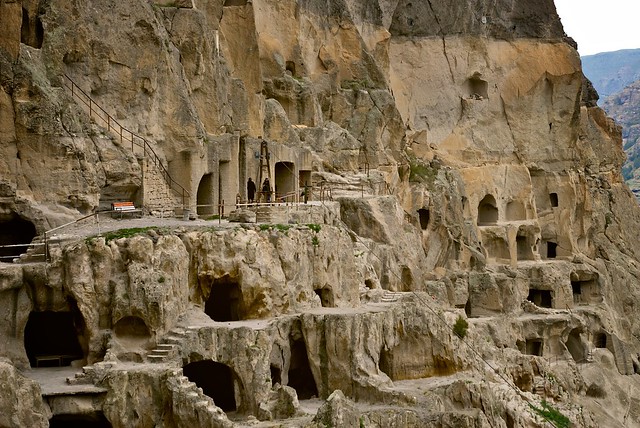Vardzia Cave Town: A Window into Medieval Georgia
Nestled in the rugged cliffs of southern Georgia lies Vardzia, an ancient cave town that has captured the imaginations of historians, travelers, and archaeologists for centuries. This remarkable site, carved into the rocky slopes of the Erusheti Mountain in the 12th century, is an awe-inspiring testament to the ingenuity, resilience, and cultural depth of medieval Georgia. Vardzia was built primarily as a monastic complex and served as both a spiritual retreat and a strategic stronghold. Its unique architecture, fascinating history, and cultural significance make it one of Georgia’s most iconic destinations, drawing visitors from around the world.
This article explores the history, architecture, significance, and visitor experience of Vardzia, offering a comprehensive look at why this cave town is one of Georgia’s greatest treasures.
1. Historical Background of Vardzia
Vardzia was constructed during the reign of King Giorgi III and his daughter, Queen Tamar, in the 12th century. At the time, Georgia was a powerful kingdom with a rich culture and strong military presence, known for its victories over neighboring empires. Queen Tamar, often considered Georgia’s greatest ruler, envisioned Vardzia as both a religious sanctuary and a defensive stronghold that would provide protection from the advancing Mongol and Seljuk invasions.
Vardzia began as a monastic complex, designed to house monks and serve as a place of worship. However, its strategic location and extensive network of caves made it an ideal fortress. Queen Tamar expanded the project to include defensive features such as hidden tunnels and lookout points. By the late 12th century, Vardzia had grown into a sprawling complex with hundreds of interconnected rooms, chapels, and corridors.
This combination of spiritual and military utility made Vardzia a unique symbol of Georgian strength and faith. Its importance, however, began to decline in 1283 after a massive earthquake caused extensive damage to the caves, exposing parts of the complex to the elements. Despite this setback, Vardzia continued to serve as a religious center for centuries, although its significance diminished with the rise of other political and religious centers in Georgia.
2. Architecture and Layout of Vardzia
The architecture of Vardzia is nothing short of extraordinary. Built directly into the face of the Erusheti Mountain, the complex features around 600 rooms spread across 13 levels. These rooms include living quarters, libraries, wine cellars, storage rooms, and several chapels. Each room and corridor was carved into the rock, showcasing the technical prowess and artistic vision of Georgian architects.
One of the most impressive parts of Vardzia is the Church of the Dormition, located at the heart of the complex. This church features exquisite frescoes that depict various religious scenes, including portraits of Queen Tamar and her father, King Giorgi III. These frescoes are notable not only for their artistic quality but also for their historical value, as they offer rare visual records of Georgian royalty. The walls of the church are adorned with scenes from the life of Christ, various saints, and other religious figures, rendered in vibrant colors that have miraculously survived the test of time.
Caves and Tunnels
The cave network of Vardzia is both intricate and extensive, consisting of a labyrinthine system of rooms and corridors connected by hidden tunnels. Many of these tunnels were designed to provide quick access to different parts of the complex, allowing monks and residents to move stealthily if the town came under attack. The builders even constructed a concealed tunnel that led to the Mtkvari River, ensuring a supply of fresh water during sieges.
The complexity of Vardzia’s design reflects its dual purpose as both a monastic retreat and a military fortress. Narrow corridors, concealed staircases, and hidden rooms were strategically arranged to confuse invaders, making it a difficult place to conquer. The architecture of Vardzia serves as a testament to the ingenuity and strategic thinking of its builders, who designed the town to be both functional and resilient.
Frescoes and Religious Art
The frescoes of Vardzia are some of the finest examples of medieval Georgian art. Painted in the 12th century, these frescoes cover the walls and ceilings of the Church of the Dormition. They depict scenes from the Bible, including the Nativity, the Crucifixion, and the Ascension, as well as portraits of saints and angels. One of the most famous frescoes is the depiction of Queen Tamar herself, dressed in royal regalia, with an inscription identifying her as “Queen of Queens.” This image of Queen Tamar is one of the few contemporary representations of her, making it a priceless piece of Georgian heritage.
The frescoes are not merely decorative; they were intended to serve as visual aids for monks and worshippers, providing a way to meditate on the lives of saints and the teachings of Christianity. The vivid colors and intricate details of these frescoes reflect the skill and devotion of Georgian artists, who poured their talents into creating art that would inspire awe and reverence.
3. Vardzia’s Strategic Importance and Defense Mechanisms
While Vardzia was primarily a monastic complex, it was also built with defense in mind. The location of the town on a steep cliff face made it difficult to access, and the interconnected tunnels allowed residents to move quickly and undetected. The complex also had fortifications, including guard rooms and lookouts, strategically placed to monitor and defend against potential invaders.
During Queen Tamar’s reign, Vardzia played a crucial role in defending Georgia from the Mongol and Seljuk invasions. The fortified caves provided shelter for monks, soldiers, and local villagers, creating a safe haven in times of conflict. The secret tunnels allowed for the movement of troops and supplies, while the natural rock formations provided a barrier against enemy forces. Although Vardzia never saw significant military action, its design and strategic location underscore the foresight of its builders, who recognized the importance of creating a space that could serve both spiritual and defensive purposes.
4. Vardzia in Georgian Culture and Religion
Vardzia holds a special place in Georgian culture and religion. It symbolizes the resilience of the Georgian people, who withstood numerous invasions and hardships to preserve their faith and identity. The complex remains an active monastic site, and its churches and chapels continue to be places of worship and pilgrimage.
For Georgians, Vardzia is more than just a historical monument; it is a spiritual symbol of their enduring connection to their past. The stories of Queen Tamar, the artistry of the frescoes, and the architectural marvel of the caves are all celebrated aspects of Georgian heritage. Vardzia is also an important pilgrimage site for Orthodox Christians, who visit the complex to pay homage to the saints and monks who lived and prayed there.
5. The Earthquake of 1283 and Subsequent Decline
The earthquake of 1283 was a turning point in Vardzia’s history. The tremor destroyed many parts of the complex, exposing the once-hidden rooms and making the town vulnerable to the elements. Many of the tunnels collapsed, and large portions of the cliff face crumbled, altering the layout of the complex. Despite repairs, Vardzia never regained its former prominence as a fortified monastic town.
Over the centuries, Vardzia’s importance continued to diminish. The rise of new political centers and shifting trade routes further contributed to its decline. By the 16th century, the complex was largely abandoned, although some monks continued to live and worship there.
Today, Vardzia is preserved as a historical and cultural site, with ongoing restoration efforts to protect its caves, frescoes, and architecture from further deterioration. While it may no longer serve its original purpose, Vardzia remains a cherished symbol of Georgian resilience and faith.
6. Visiting Vardzia: A Traveler’s Guide
Visiting Vardzia is a journey into the past, offering travelers the chance to explore one of Georgia’s most remarkable historical sites. The journey to Vardzia itself is an adventure, as it is located in a remote part of southern Georgia, near the border with Turkey. However, the breathtaking landscapes and the allure of the ancient caves make the trip well worth the effort.
Getting There
The closest major city to Vardzia is Akhaltsikhe, which is accessible by road from Tbilisi, the capital of Georgia. From Akhaltsikhe, visitors can take a taxi or a marshrutka (minibus) to Vardzia. The journey takes about an hour and offers scenic views of the Georgian countryside, including the Mtkvari River and surrounding mountains.
Exploring the Caves
Visitors to Vardzia can explore the cave complex on foot, walking through the ancient rooms, corridors, and chapels. Some parts of the complex have been restored and are safe for visitors, while others are more rugged and may require caution. Guides are available to provide historical insights and lead tours, which can enhance the experience by bringing the history and significance of Vardzia to life.
The highlight of the visit is the Church of the Dormition, where visitors can see the famous frescoes of Queen Tamar and other religious figures. The views from the cliff face are also breathtaking, offering a panoramic look at the surrounding landscape.
Practical Information for Visitors
- Best Time to Visit: The best time to visit Vardzia is during the spring or fall when the weather is mild. Summers can be hot, while winters bring snow and icy conditions, making the roads difficult to navigate.
- Entrance Fees: There is an entrance fee for Vardzia, which helps fund the maintenance and preservation of the site.
- Amenities: While Vardzia is a remote location, there are a few guesthouses and restaurants in the nearby village, providing basic accommodations for travelers who wish to stay overnight.

